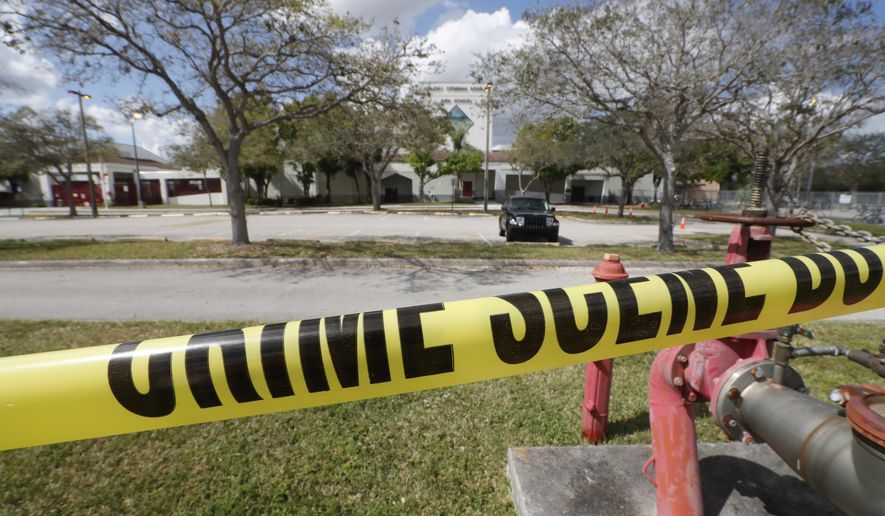One of the big unknowns in the gun debate is the actual role mental health plays in fueling mass shootings. And analysts say the reason it’s still unknown is because a provision of federal law has prevented the federal government from funding that research for more than two decades.
The Trump administration this month suggested some cracks in the ban. Health and Human Services Secretary Alex Azar said he sees room for the Centers for Disease Control and Prevention to fund some research — but not actual lobbying efforts.
CDC cash could spur the country’s major research universities, which have been reluctant to spend their own money on the issue.
“We’re in the science business and the evidence-generating business, and so I will have our agency certainly working in this field, as they do across the broad spectrum of disease control and prevention,” Mr. Azar said at a hearing on Capitol Hill.
It remains to be seen, however, whether Congress will push the CDC to go further.
Democrats have vowed to push to change the law and completely remove the study ban. Key Republican lawmakers, though, doubted they would take that step because they have already written the 2018 spending bills to continue the prohibition and it doesn’t make sense to jeopardize the spending bill over that issue.
“I imagine it’ll be reviewed next year but seems to me a pretty small piece of a trillion-dollar-plus spending bill,” said Rep. Tom Cole, Oklahoma Republican and chairman of the House Appropriations subcommittee that oversees CDC funding.
The ban dates back to 1996. It prohibits federal funding “from being used to advocate or promote gun control.” Originally pushed by Rep. Jay Dickey of Arkansas, it is now routinely included in annual spending bills.
Mr. Dickey said later that his original intention was not to completely quash federally funded research into the causes of gun violence.
But gun control activists say that was exactly what happened. They say the amendment sent a clear message that federal researchers should steer clear of the issue.
“I think of it this way: If you’re a young researcher, young epidemiologist, and you’re thinking of which area you want to specialize in, and you can choose either an area that gets no federal funding or an area that gets tens of millions of dollars of federal funding annually, which one might you choose?” said Avery Gardiner, co-president of the Brady Campaign to Prevent Gun Violence.
Private universities and foundations do fund gun studies on their own, but government money is such a vital source of research funding in general that if the government decides not to do it, the broader research suffers, said Robert Spitzer, a professor at State University of New York at Cortland who has written multiple books about gun policy.
He said the CDC probably could have spent money on the studies, but it too was cowed by Congress.
“They want to avoid any political heat that might endanger their other programs,” he said in an email.
Mr. Azar’s announcement that he believes the current language allows some research changes all that, said Sen. Roy Blunt, Missouri Republican and chairman of the Senate Appropriations subcommittee that oversees CDC money.
“He knows they can do this research if they want to, so I don’t think there’s any further need to clarify that,” Mr. Blunt said.
Democrats, though, don’t want to leave the matter to interpretation.
“We have a lot of work to do in order to undo [the] harm that the gun lobby did,” said Sen. Christopher Murphy, Connecticut Democrat and a leading gun control voice in Congress.
Sen. Edward J. Markey, Massachusetts Democrat, sent a letter to Mr. Azar asking him to clarify the situation and in particular to ask if he supported a congressional repeal of the money ban altogether.
“As a consequence of the rider, policymakers, healthcare practitioners, researchers, and others have lacked comprehensive, scientific information about the causes and characteristics of gun violence or the best strategies to prevent it,” Mr. Markey wrote.
“The tragedy in Parkland, Florida, once again reminds us that it is long past time we change that,” he said.
The National Rifle Association, a leading proponent of the original language, has said it is not opposed to federal gun research per se but that some of the CDC’s initiatives in the 1990s drifted toward advocacy on the issue.
The original ban was spurred in part by a 1993 study published in the New England Journal of Medicine that associated keeping a gun in the home with an increased risk of homicide by a family member or close acquaintance.
Dickey, who died last year, acknowledged that the language did morph into an effective ban on federal research into the issue, but he said that was not what he was trying to do.
“I was on to other things and worrying about my constituents,” he told NPR in 2015. “And I didn’t follow through and say, we … still need to do research. I didn’t do that.”
Mark Rosenberg, the director of CDC’s center for injury prevention in 1996, thinks the language is helpful because it ensures any research isn’t tainted by anti-gun bias.
“Today, I believe the Dickey amendment should be preserved, to assure those on the gun-rights side of the debate that none of the funds they send to CDC will be used to lobby for gun control legislation and that these funds will be used only to support scientific research,” Mr. Rosenberg wrote this month in Politico.
• David Sherfinski can be reached at dsherfinski@washingtontimes.com.




Please read our comment policy before commenting.